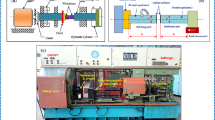Abstract
Formability and its fracture characteristics are critical factors in fabricating spring components from sheet base materials. Copper-nickel-beryllium (C17510) alloys provide excellent formability for producing highly reliable connectors used in electrical and electronic applications. The formability of a commercially available CuNiBe alloy was studied with emphasis on springback evaluations. Experiments were conducted to investigate the forming related tensile and bending properties. Fractographical examinations were conducted to identify the characteristics of failure and predict its initiation. Several analytical formulas for predicting springback are presented herein to provide a simple tool for computer-assisted design of spring components. To verify their reliability, the analytical predictions were first compared with the experimental data. Then predictions based on different formulations were compared with each other to identify an appropriate formula to be used in design of the highly reliable spring components.
Similar content being viewed by others
References
ASTM B 534-91, Copper-Cobalt-Beryllium Alloy and Copper-Nickel-Beryllium Alloy Plate, Sheet, Strip, and Rolled Bar,Annual Book of ASTM Standards, Vol 02.01, American Society for Testing and Materials, 1992, p 644–646
A.A. Tseng, K.P. Jen, N.A. Gildersleeve, and T. Ochiai, A Formability Analysis of Beryllium Copper Strip,IIC1T Conn-Cept ’92:25th Annual Connector and Interconnection Technology Symposium, Int. Institute of Connector and Interconnection Technology, 1992, p 465–480
D. Williamson, Micromanufacturing at the Crossroad,Manuf. Eng., Vol 95 (No. 6), 1985, p 34–40
A.A. Tseng, Materials Characterization and Finite Element Simulation for Forming Miniature Metal Parts,Finite Elements in Analysis and Design, Vol 6, 1990, p 251–265
C. Wick, J.T. Benedict, and R.F. Veilleux, Forming,Tool and Manufacturing Engineers Handbook, Vol 2, Ed., Society of Manufacturing Engineers, 1985, p 10.10–10.30
S. Kalpakjian,Manufacturing Processes for Engineering Materials, 2nd ed., Addison-Wesley, 1991
Metallography and Microstructure,Metals Handbook, 9th ed., Vol 9, American Society for Metals, 1985, p 393–395
G. Vander Voort,Metallography: Principles and Practice McGraw-Hill, 1984, p 625
ASTM E 8M-86a, Methods of Tension Testing of Metallic Materials [Metric],Annual Book of ASTM Standards, Vol 03.01, American Society for Testing and Materials, 1987, p 199–222
ASTM E 646-78, Test Method for Tensile Strain-Hardening Exponents (n-Values) of Metallic Sheet Materials,Annual Book of ASTM Standards, Vol 03.01, American Society for Testing and Materials, 1987, p 704–711
A.K. Ghosh, S.S. Hecker, and S.P. Keeler, Sheet Metal Forming and Test,Workability Testing Techniques, G.E. Dieter, Ed., American Society for Metals, 1984, p 135–195
W .F. Hosford and R.M. Caddell,Metal Forming: Mechanics and Metallurgy, Prentice-Hall, 1983
C. A. Queener and R.J. De Angelis, Elastic Springback and Residual Stresses in Sheet Metal Formed by Bending,Trans ASM Vol 61, 1968, p 757–768
Author information
Authors and Affiliations
Rights and permissions
About this article
Cite this article
Tseng, A.A., Chen, T.C., Jen, K.P. et al. Forming and fractographical characteristics of Copper-Nickel-Beryllium sheets under tension and bending. JMEP 3, 619–634 (1994). https://doi.org/10.1007/BF02645260
Issue Date:
DOI: https://doi.org/10.1007/BF02645260




